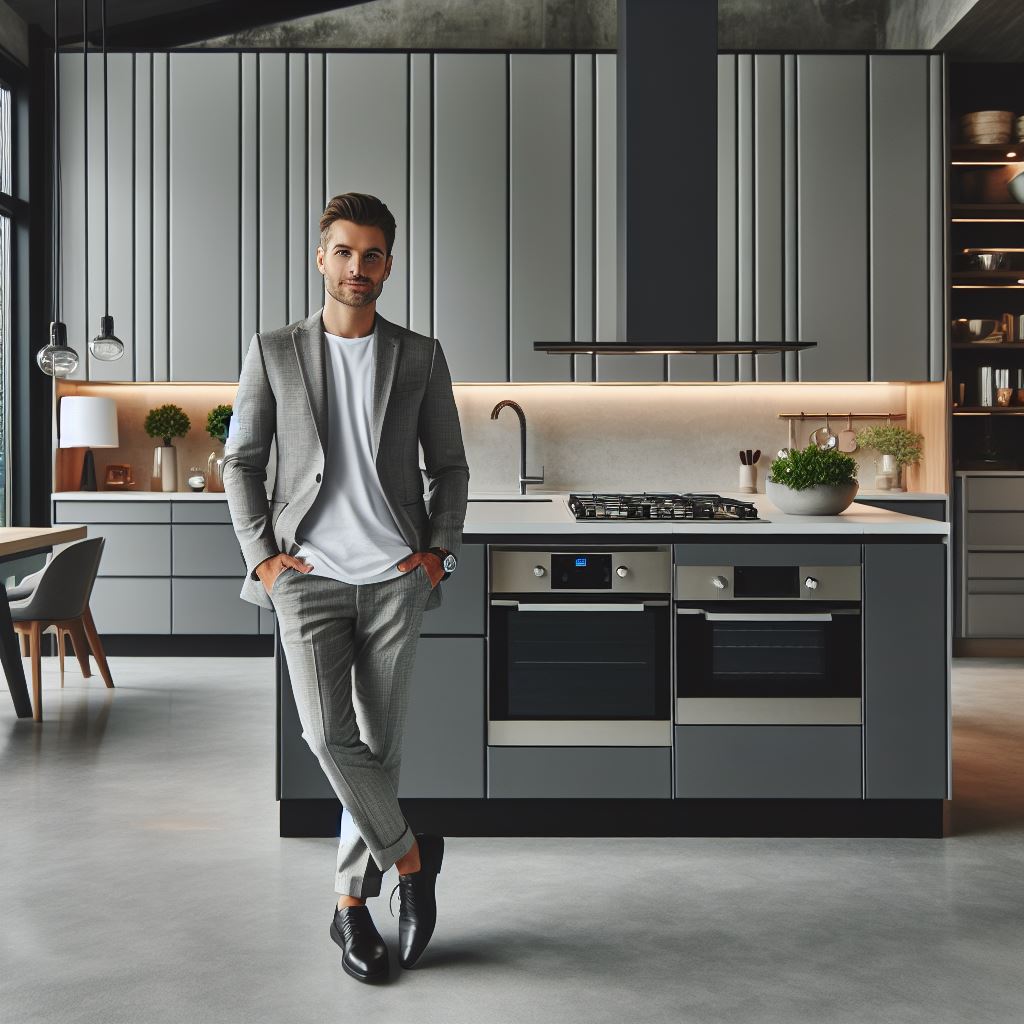Introduction
In the ever-evolving landscape of interior design, kitchens stand as the beating heart of modern homes.
No longer confined to the realm of mere functionality, today’s kitchens seamlessly blend aesthetics with cutting-edge technology, offering a space that caters to both culinary enthusiasts and design aficionados alike.
As we step into 2024, the quest for the perfect kitchen is more exciting than ever, with a myriad of design must-haves transforming these spaces into stylish, efficient hubs of contemporary living.
The importance of a well-designed kitchen cannot be overstated.
Beyond its traditional role as a place for meal preparation, the modern kitchen serves as a social hub, a place where families gather, and friends connect.
It’s the epicenter of entertaining, a space where memories are made, and culinary experiments come to life.
As homes increasingly embrace open floor plans, the kitchen has become a focal point, making its design a critical element in shaping the overall ambiance of the living space.
In the hustle and bustle of today’s fast-paced lifestyle, efficiency is key.
A thoughtfully designed kitchen streamlines daily routines, making the cooking process a joy rather than a chore.
From smart storage solutions to intuitive layouts, the design elements of a kitchen play a pivotal role in enhancing functionality and ease of use.
As we delve into the realm of 2024 kitchen design, it’s essential to unravel the trends and must-haves that define the contemporary culinary space.
From futuristic appliances to sustainable materials, the landscape is dynamic and diverse.
This post will explore the key elements that make up the DNA of modern kitchens in 2024, offering insights into the fusion of form and function that elevates these spaces into the epitome of style and efficiency.
Get ready to embark on a journey through the latest innovations, color palettes, and design philosophies that are shaping the kitchens of tomorrow.
Trend 1: Integrated Appliances
In the ever-evolving world of modern kitchens, the integration of appliances has become a cornerstone of contemporary design.
This trend not only enhances the aesthetic appeal of kitchens but also maximizes functionality, making it a must-have for kitchens in 2024.
Benefits of Integrated Appliances
Integrated appliances offer a seamless and cohesive look to kitchen spaces.
By blending seamlessly with cabinetry, these appliances create a unified and clutter-free environment.
This design approach is not just about appearances; it also optimizes space utilization, a critical aspect in today’s compact living spaces.
Beyond aesthetics, integrated appliances provide ease of maintenance, as their concealed nature prevents dirt and grime from accumulating on the surfaces.
Moreover, integrated appliances contribute to a more efficient kitchen workflow.
With everything neatly tucked away, the kitchen becomes a space where form meets function effortlessly.
The elimination of protruding elements also facilitates easier cleaning, as there are no nooks and crannies for dust to settle.
Examples of Popular Integrated Appliances
As of 2024, several integrated appliances have gained popularity in modern kitchens.
Built-in refrigerators seamlessly merge with cabinetry, maintaining a uniform look.
Dishwashers hidden behind custom panels ensure a cohesive appearance.
Induction cooktops integrated into countertops not only save space but also provide a sleek and modern cooking surface.
In addition, ovens, microwaves, and coffee makers can be discreetly integrated, adding to the overall streamlined aesthetic.
Smart home integration is another rising trend, with appliances featuring advanced connectivity for enhanced control and automation.
Potential Future Developments in Integrated Appliances
Looking ahead, the integration of technology is expected to play a pivotal role in shaping the future of kitchen design.
Smart appliances with artificial intelligence capabilities could revolutionize the way we interact with our kitchens.
Imagine a refrigerator that suggests recipes based on its contents or an oven that learns your cooking preferences over time.
Furthermore, sustainable design is likely to influence the development of integrated appliances.
Energy-efficient and eco-friendly features will become integral, aligning with the growing awareness of environmental responsibility.
In short, the trend of integrated appliances in modern kitchens is not merely a fleeting fashion but a transformative design philosophy.
As we move further into 2024, the seamless fusion of technology, aesthetics, and sustainability will continue to drive innovation in integrated kitchen appliances, creating spaces that are not only stylish but also highly functional.
Read: Creating a Renovation Budget Spreadsheet
Trend 2: Smart kitchen technology
Introduction to Smart Kitchen Technology
In the fast-evolving landscape of kitchen design, one trend stands out as revolutionary: smart kitchen technology.
As we step into 2024, the integration of cutting-edge technology into our culinary spaces is no longer a luxury but a necessity.
Smart kitchen technology is reshaping the way we cook, interact, and even think about our kitchens.
Advantages of Incorporating Smart Technology in Kitchen Design
The incorporation of smart technology in kitchen design offers a myriad of advantages.
Firstly, it enhances efficiency. Imagine a kitchen that anticipates your needs, adjusting lighting, temperature, and even reminding you of expiration dates.
Smart kitchens streamline daily tasks, saving time and effort
Secondly, connectivity is a key advantage.
With the rise of the Internet of Things (IoT), smart kitchen appliances can communicate seamlessly.
Your refrigerator can alert the oven to preheat when you’re on your way home, ensuring a seamless cooking experience.
This level of interconnectivity not only enhances convenience but also optimizes energy usage.
Examples of Smart Kitchen Appliances and Gadgets
The market is flooded with innovative smart kitchen appliances and gadgets.
Smart refrigerators equipped with cameras allow you to peek inside while grocery shopping.
Intelligent ovens can be controlled remotely through smartphone apps, ensuring your roast is perfectly cooked even when you’re not in the kitchen.
Voice-activated assistants, like those integrated into smart speakers, are becoming kitchen companions, helping with recipes, conversions, and timers.
Future Prospects for Smart Kitchen Technology
Looking ahead, the future of smart kitchen technology is promising.
Expect to see advancements in artificial intelligence, machine learning, and sensor technology.
Smart kitchens will become even more intuitive, learning your preferences and adapting to your cooking style.
Personalized nutrition recommendations, waste reduction through smart inventory management, and enhanced security features are just a glimpse of what the future holds for smart kitchen technology.
In a nutshell, smart kitchen technology is not just a trend but a transformative force in modern kitchen design.
Embracing this technological wave promises a more efficient, connected, and enjoyable culinary experience for homeowners in 2024 and beyond.
Read: Cost-Effective Outdoor Space Renewal

Trend 3: Minimalistic and clean designs
Shift towards simple and streamlined kitchen aesthetics
In recent years, there has been a noticeable shift towards minimalistic kitchen designs.
Homeowners are embracing the idea of simplicity and cleanliness in their kitchens.
Instead of cluttered and busy spaces, they are opting for a more streamlined and organized look.
Gone are the days of intricate designs, ornate cabinetry, and excessive decoration.
The modern kitchen is all about smooth lines, sleek surfaces, and a minimalistic approach.
This trend is not just about appearance but also about creating a functional and efficient space.
Features of a minimalistic kitchen design
A key characteristic of a minimalistic kitchen design is the absence of unnecessary clutter.
Everything has its place, with plenty of storage options to keep the countertops and surfaces free from mess.
Clean lines and open spaces contribute to a sense of calm and tranquility in the kitchen.
Minimalistic kitchens often feature flat-panel or handle-less cabinets, giving a seamless and uninterrupted look.
Materials such as stainless steel, glass, and concrete are commonly used to create a contemporary and minimalist vibe.
The color palette is usually neutral, with shades of white, gray, and black dominating the space.
Advantages of minimalistic designs in terms of functionality and maintenance
One of the advantages of a minimalistic kitchen design is its focus on functionality.
With fewer distractions and unnecessary elements, it becomes easier to navigate and find what you need.
Cooking and preparing meals become a more efficient and enjoyable experience in a clutter-free environment.
Maintenance is also a breeze in a minimalistic kitchen.
With fewer surfaces and items to clean, it takes less time and effort to keep the space spotless.
Spills and stains are easily spotted and addressed, preventing any long-term damage to the kitchen.
Predictions for the future of minimalistic kitchen designs
As we look into the future, it is clear that minimalistic kitchen designs will continue to gain popularity.
The rise of smart technologies and appliances will further enhance the minimalist approach.
Integrated storage solutions and hidden compartments will become more prevalent, allowing for a seamless and uncluttered look.
Additionally, sustainability will play a crucial role in the evolution of minimalistic kitchen designs.
Eco-friendly materials and energy-efficient appliances will be prioritized, ensuring that the kitchen is not only aesthetically pleasing but also environmentally responsible.
Basically, minimalistic and clean designs are becoming a staple in modern kitchens.
With their emphasis on simplicity, functionality, and maintenance, these designs offer a practical and stylish solution for homeowners.
As we move towards the future, we can expect the minimalistic trend to continue evolving, incorporating new technologies and sustainable practices.
Read: Interior Lighting: 2024’s Brightest Trends
Trend 4: Sustainable materials
The importance of eco-friendly kitchen designs is growing rapidly in modern kitchens.
Using sustainable materials for kitchen countertops, cabinets, and flooring is becoming increasingly popular.
Growing importance of eco-friendly kitchen designs
- Environmental awareness and sustainability have become significant factors in modern kitchen design.
- Homeowners are increasingly considering the impact of their kitchen materials on the environment.
- Eco-friendly kitchen designs can contribute to a healthier and greener lifestyle.
Examples of sustainable materials for kitchen countertops, cabinets, and flooring
- Bamboo: A popular choice for countertops, cabinets, and flooring due to its renewable nature and durability.
- Recycled Glass: Provides a unique and stylish look while reducing the need for virgin materials.
- Reclaimed Wood: Gives a rustic and unique touch to kitchen design while reducing deforestation.
Benefits of using sustainable materials in kitchen design
- Environmental Impact: Sustainable materials reduce the depletion of natural resources and minimize carbon footprints.
- Health Benefits: Eco-friendly materials are often non-toxic, ensuring a safer environment for food preparation.
- Long-Term Cost Savings: Sustainable materials are durable and require less maintenance, saving money in the long run.
Potential future advancements in sustainable kitchen materials
- Bio-based Materials: Materials derived from renewable sources like plants or agricultural waste.
- Solar Panels: Integrated solar technology in kitchen design to harness natural energy.
- Water-saving Technology: Innovations that promote efficient use of water within the kitchen.
All in all, the use of sustainable materials in kitchen design is becoming increasingly important in modern kitchens.
These materials not only contribute to a greener environment but also offer aesthetic appeal and long-term cost savings.
As technology advances, we can expect even more innovative and eco-friendly materials to revolutionize kitchen design in the future.
Read: Affordable Eco-Friendly Home Upgrades
Trend 5: Multifunctional and flexible spaces
Evolution of the kitchen as a versatile living space
In recent years, the kitchen has transformed from a mere cooking area to a multifunctional living space.
It has become the heart of the home, where families gather, meals are cooked, and memories are made.
This evolution has been driven by the changing lifestyles and needs of modern homeowners.
Examples of multifunctional kitchen features
One of the key elements of a modern kitchen is the integration of multifunctional features.
These features are designed to maximize the efficiency and usability of the space.
For example, the kitchen island has become a staple in contemporary kitchen design.
It serves not only as a preparation area but also as a work desk, dining table, and even a social hub.
Another popular feature is the inclusion of flexible storage solutions.
Cabinets and drawers can be customized to accommodate various items, from cookware to office supplies.
This allows homeowners to organize their kitchen space according to their specific needs.
Advantages of incorporating flexible spaces in kitchen design
The incorporation of flexible spaces in kitchen design offers several advantages.
Firstly, it allows for better utilization of the available area.
By having a multifunctional kitchen, homeowners can maximize the use of every square inch, making the space more efficient and functional.
Secondly, a flexible kitchen space promotes better organization.
With customizable storage solutions, homeowners can easily access and store their belongings, reducing clutter and improving overall efficiency.
Lastly, a versatile kitchen design enhances the overall experience of the users.
It creates a welcoming and comfortable atmosphere where family and friends can gather, work, and dine together, fostering a sense of togetherness and connection.
Predictions for the future of multifunctional kitchen spaces
As we look into the future, the trend of multifunctional and flexible kitchen spaces is expected to continue growing.
With advancements in technology and design, homeowners can expect even more innovative features and solutions.
We can anticipate the integration of smart appliances and interactive surfaces, which will further enhance the functionality and convenience of the kitchen.
Imagine a countertop that can display recipes or a fridge that can suggest healthy meal options based on the items inside.
Furthermore, the concept of flexible spaces will extend beyond the kitchen itself.
Open-concept designs will continue to dominate, blurring the boundaries between the kitchen, dining, and living areas.
This seamless integration will create a cohesive and harmonious living space that promotes interaction and collaboration.
Ultimately, the evolution of the kitchen into a multifunctional and flexible living space has revolutionized modern home design.
With the inclusion of versatile features and customizable storage solutions, homeowners can create a space that meets their unique needs and enhances their overall living experience.
As we move forward, we can expect even more innovative advancements that will continue to redefine the concept of the modern kitchen.
Conclusion
Modern kitchens in 2024 will require a combination of functionality, smart technology, and eco-friendly features.
Every kitchen should have plenty of storage space, well-planned layouts, and multipurpose islands for cooking and dining.
Additionally, incorporating smart appliances and home automation systems will become essential for convenience and efficiency.
Finally, focusing on sustainability by integrating energy-efficient appliances and eco-friendly materials will be a must-have for environmentally conscious homeowners.
Staying updated with design trends is crucial to ensure your kitchen remains stylish, functional, and valuable.
By constantly adapting to new concepts, materials, and technologies, you can enhance the aesthetic appeal and functionality of your kitchen.
Being aware of the latest design trends will also help you make informed decisions during renovations or when designing a new kitchen.
Plus, keeping up with trends allows you to create a space that reflects your personality and keeps your home feeling fresh and modern.
In the end, modern kitchens in 2024 will be a harmonious blend of functionality, style, and sustainability.
By incorporating the key design must-haves discussed in this post, you can create a kitchen that is not only visually stunning but also efficient and eco-friendly.
Stay updated with design trends to ensure your kitchen remains on-trend and valuable.
Remember, a well-designed kitchen is not only a joy to use but also a valuable asset that enhances your daily life.
So, embrace the trends, explore new ideas, and design the modern kitchen of your dreams!




